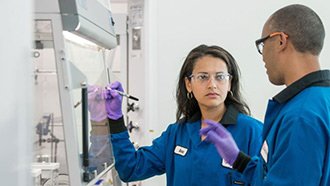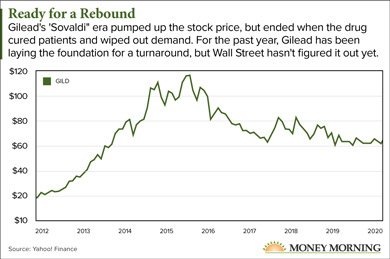Gilead stock doesn't make a particularly strong first impression. But investors who overlook GILD stock are missing one of the industry's best investments.
 Since peaking in June 2015, shares of this biotech firm are down 43% at a time when the S&P 500 index was moving in the opposite direction, shooting up 58%. Sales are down 31.2% over the past four years. Net income is down 55.8%.
Since peaking in June 2015, shares of this biotech firm are down 43% at a time when the S&P 500 index was moving in the opposite direction, shooting up 58%. Sales are down 31.2% over the past four years. Net income is down 55.8%.
And the price-to-earnings ratio is a lofty 33.0.
So why am I telling you this is a good stock to buy?
For one thing, Gilead has a Money Morning Stock VQScore™ of 4.5. The VQScore is a proprietary system that identifies stocks likely to experience a price jump.
Historic FDA Approval: This biotech just received FDA approval for a first-of-its-kind treatment for a growing health crisis. There's still time to get in on the biggest gains - if you act fast. Click here to get this FREE pick now.
And Gilead Sciences Inc. (NASDAQ: GILD) has more going for it than those numbers suggest.
Gilead's future is much brighter than its past, and as investors, that's what we care about.
Before I get into what lies ahead for Gilead, let me give you an overview of the business...
The Gilead Sciences Backstory
Gilead describes itself as "a research-based biopharmaceutical company that discovers, develops, and commercializes innovative medicines in areas of unmet medical need."
It focuses on drugs that treat HIV, hepatitis C, cell therapy, and influenza. Gilead gets the bulk of its revenue - about 74% - from its HIV drugs.
The reason for the GILD stock price decline can best be summed up as "no good deed goes unpunished."
Gilead acquired a company called Pharmasset in 2011 that had developed a drug called Sovaldi that essentially cured hepatitis C. The U.S. Food and Drug Administration (FDA) approved it in 2013.
Within two years, Sovaldi and its derivatives tripled Gilead's sales. Profits more than quintupled, from $3.45 billion to $19.17 billion.
 Gilead stock rocketed 475% from when it acquired Pharmasset in November 2011 to its peak in July 2015.
Gilead stock rocketed 475% from when it acquired Pharmasset in November 2011 to its peak in July 2015.
But Sovaldi is not just a treatment for hepatitis. It's a cure. That meant the pool of patients needing the drug began shrinking rapidly.
Gilead also got caught up in the 2016 outrage over high drug prices. A full 12-week treatment with Sovaldi cost $84,000. CEO John C. Martin was called to Washington to testify at a Senate hearing.
In the years that followed, Gilead began offering substantial discounts on Sovaldi.
The combination of cured hepatitis C patients and government-induced pricing pressure cut Gilead's revenue in half by 2018. And profits fell by more than half, to $8.73 billion.
More recently, Gilead has faced multiple patent lawsuits, including one that affects its Yescarta cancer drug and another concerning its Biktarvy HIV drug. The overhang from these lawsuits has also helped depress GILD stock.
And that brings us to the present - and why Gilead stock is a buy...
Why Gilead Stock Is a Buy
[mmpazkzone name="in-story" network="9794" site="307044" id="137008" type="4"]
It's tough for a company to replace the profits from a "shooting star" product like Sovaldi. But Gilead has developed a long-term strategy that will pay off over the next couple of years.
It starts at the top.
Back in March 2019, former Roche Pharmaceuticals (OTCMKTS: RHHBY) CEO Daniel O'Day arrived to take the reins of the company. Within the first several months, he overhauled the company's top management.
O'Day also took steps to mitigate the impact of the Yescarta patent case, which called for Gilead to pay $585 million in damages as well as 27.6% of running royalties on sales of the drug.
Gilead acquired Yescarta when it purchased Kite Pharma in 2017. When he became CEO, O'Day made Kite a separate company and gave it its own CEO. That will make it easier to sell off Kite - perhaps the best way to deal with a difficult situation.
O'Day also acted boldly in solidifying the company's relationship with Galapagos NV (NASDAQ: GLPG).
In July, Gilead pumped $5.1 billion into the "baby biotech" in a 10-year deal that gives Gilead exclusive rights outside Europe to develop and commercialize all of Galapagos' current and future drugs. Galapagos currently has more than 20 drugs in development.
That represents a valuable pipeline for future revenue for Gilead.
And the company will start reaping the rewards as early as this year...
These Future Blockbusters Will Drive GILD Stock Higher
And first in line is Galapagos' rheumatoid arthritis treatment, filgotinib. This promising drug had been stuck in a late stage of the FDA approval process until O'Day found a way to nudge it forward.
Filgotinib is expected to launch before the end of the year. Analysts estimate annual sales will ultimately reach "blockbuster" status and range between $4 billion and $6 billion.
It's hard to estimate what Galapagos' other projects will yield (and when), but even a few modest successes will make a contribution.
There's also Gilead's in-house development. The most promising drug, GS-6207, is another HIV treatment. It's currently in phase 2, so it won't be available this year. But last year, RBC Capital Markets analyst Brian Abrahams said GS-6207 could be Gilead's most successful HIV drug yet. He put a net present value on the drug of $20 billion.
Meanwhile, the hepatitis C business is expected to keep chugging along, providing a strong foundation as the company brings its new drugs to market.
Gilead is also looking to expand sales in China, obviously a huge market. The company has had eight products approved since 2017, including HIV drugs Biktarvy and Descovy as well as hepatitis treatments Vemlidy and Vosevi.
Gilead also has plenty of dry powder - $25.8 billion in cash - available for licensing deals or small- to medium-sized acquisitions. Either would further pad the company's drug pipeline and revenue stream.
"I do believe that Gilead is in a sweet spot," O'Day told STAT.com, a healthcare news website owned by Boston Globe Media. "Sometimes I refer to it as a teenager in an adult's body: It's still an entrepreneurial biotech company, but it has this extraordinary firepower."
Action to Take: Establish a position in GILD, currently trading at about $67. Buy more on pullbacks. Don't expect big gains right away; this stock is likely to trade sideways for most of 2020 before it starts to make its move higher. You'll be paid handsomely while you wait: Gilead pays a dividend yield of 4%.
California's Solar Mandate Could Mean $153 Billion for "Dark Burst" Investors
California's new energy mandate requires solar energy technology on every new home built this year - leaving every contractor, developer, and homebuilder in the Golden State scrambling to secure this $150 device.
This patented "Dark Burst" technology could hold a virtual monopoly over a critical U.S. industry.
Today, you have one last chance to lock in a ground-floor opportunity before Silicon Valley insiders pounce on a projected 10,285% sales surge. Click here to learn more...
Follow me on Twitter @DavidGZeiler and Money Morning on Twitter and Facebook.
About the Author
David Zeiler, Associate Editor for Money Morning at Money Map Press, has been a journalist for more than 35 years, including 18 spent at The Baltimore Sun. He has worked as a writer, editor, and page designer at different times in his career. He's interviewed a number of well-known personalities - ranging from punk rock icon Joey Ramone to Apple Inc. co-founder Steve Wozniak.
Over the course of his journalistic career, Dave has covered many diverse subjects. Since arriving at Money Morning in 2011, he has focused primarily on technology. He's an expert on both Apple and cryptocurrencies. He started writing about Apple for The Sun in the mid-1990s, and had an Apple blog on The Sun's web site from 2007-2009. Dave's been writing about Bitcoin since 2011 - long before most people had even heard of it. He even mined it for a short time.
Dave has a BA in English and Mass Communications from Loyola University Maryland.



